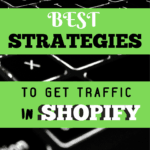Editor’s note: Today’s guestblogger is Josip Cvtila and he has a great article about Shopify traffic strategies. You are in for a real treat because Josip is a top marketer in his home country of Croatia. I hope you enjoy this week’s amazing article on driving traffic to your Shopify store. If you don’t have a store and want to start one then click here.
For another awesome article by Josip, check out this one here on whether to pick a niche or general store for your Shopify store. If you ever find yourself asking “How do I get traffic to my shopify store?” then sit back and relax for these top 10 strategies. If you don’t know what dropshipping is then go here.
“When you speak to everyone, you speak to no one.” – Meredith Hill
For as long as I have been doing marketing, this has been one of my absolute favorite quotes. It not only speaks one of the biggest truths about business, but does so with such elegance that one must be a fool not to listen to it.
So you’ve spent the last couple of months building your Shopify store from the ground up, you’ve made your own:
- Custom product images
- Written an intriguing copy for every description
- Fully optimized the layout and design
And now you’re finally ready to start rock’n’rolling and bringing actual customers onto your site.
But do you know how exactly you will go about doing so? You might think you do, but do yourself a favor and just sit down and listen to what might just be one of the most crucial pieces of information you have heard in these last 341 days.
If you don’t actually own a Shopify store or are not even in the eCommerce sector, I’ve got you covered. The techniques and strategies that I am about to share with you can be immediately applied to any type of website you might have, be it a blog, a business site or just a photo post of your cat munching on those pesky old curtains you bought two years ago on a sale in your neighbor’s yard.
Sign up for Shopify now with a 14 day free trial!
P.S. don’t worry, if you apply the techniques I am about to teach you, you will undoubtedly be able to buy new curtains very soon.
So if you’re all set, let’s get this party started!
Different Traffic Types and What They Mean for Your Business
Of course there are multiple different types of traffic, what did you think?
We can actually look at website traffic from two separate perspectives. One way is to look at where your Shopify traffic comes from, the other is all about how interested those customers are in what you have to offer.
Traffic Types by Source
We differentiate 6 basic types of traffic with regard to how they found and landed on your site, these are:
- Organic Traffic – the bread and butter of Search Engine Optimization (SEO) and also one of the most powerful and highest-converting traffic types. Organic traffic is any traffic that lands onto your website by having searched a phrase or keyword on a search engine (e.g. Google, Yahoo, Bing, etc.) and then clicking on a link that runs directly to your site.
- Direct Traffic – if someone is already familiar with your business/brand or they somehow just know the URL of your website so they enter it directly into a web browser, that is what we call direct traffic. Unfortunately, you do not have much control over this type and the only way to generate more direct traffic to your site is to make sure as many people as possible know about it.
- Paid Traffic – this type of Shopify traffic refers to those customers who land on your website through paid advertising. Google Ads is currently the most frequently used platform for PPC (pay-per-click) campaigns, although there are other platforms as well that you can utilize for this purpose.
- Email Traffic – in case you weren’t able to guess, email traffic is all traffic that lands on your website after having clicked a link contained within one of your marketing emails. Email marketing can be a very efficient marketing mechanism so make sure you spend enough time adjusting and optimizing your email sequences correctly.
- Social Traffic – with more and more people using social media such as Facebook, Instagram, YouTube, Pinterest, etc., it’s really no wonder that this is one of the most common types of traffic. Social traffic refers to all customers that have come to your site by clicking on a link on any of the social media platforms.
- Referral Traffic – tightly connected to your SEO strategy, referral traffic heavily relies upon how good and efficient your link building efforts are. In other words, if someone lands on your website by clicking an external link on other websites, we call that referral traffic.
Traffic Types by Interest
We can also look at traffic from a different angle. Let’s say that, for any reason, you do not care as much about where your traffic actually came from but would rather want to know how interested they are in what they can get from you. Here we differentiate three distinct traffic types.
- Cold Traffic – cold traffic consists of people who visit your website but have no clue as to who you are and especially what your offer is. In the beginning stages of every business development as well as prior to creating a well-established brand, cold traffic will most certainly account for the majority of your total traffic. It is often the case that this kind of traffic has incredibly low conversion rates due to no trust having been established between the customer and your business.
- Warm Traffic – customers within this traffic type are most often returning visitors to your website. They might have subscribed to you before or have just heard about your business from a friend or a colleague. In any case, they do know a bit about you and what you do/sell (i.e. they have some kind of familiarity with your business). Of course, the level of how warm they actually are highly depends on how involved they have been with your website (and you) thus far. In general, warm traffic converts much better than cold traffic.
- Hot Traffic – hot traffic is without a doubt the best kind of traffic because we are talking about customers who already know your brand very well, often have much previous experience in doing business with you and have a problem, for which your product or service is the perfect solution. They always spend the most money with you and also trust you the most so ensuring the best possible customer experience (CX) for them is an absolute must.
Sign up for Shopify now with a 14 day free trial!
Theory in Practice – Getting the Best Traffic onto Your Website in 2019
Now that we’ve familiarized ourselves with different types of website traffic, it’s finally time for the fun part – getting people to visit your website.
Total revenue you are able to generate from your business is directly related and proportional to the number of people you can get onto your site. Since no business is ever perfect and only a small percentage of your visitors will actually buy from you (we call that percentage conversion rate – CR), it makes sense that driving as much traffic as possible onto the site is in your very best interest.
So let’s go over 10 different ways you can accomplish that task most effectively, shall we?
Top 10 Ways To Boost Shopify Traffic
- Advertise
- Be Social
- Do On-Page SEO
- Become a Guest Blogger
- Use Long-Tail Keywords
- Interview Market Segment Leaders
- Incorporate Email Marketing
- Fix Speed and Responsiveness
- Research Your Competition
- Show Yourself in the Comments
#1 Advertise for more Shopify Traffic
What? Are you seriously telling me that one of your “big secrets” to driving quality Shopify traffic is one of the things almost every business is already doing?
Yes. Yes, I am.
As of June this year, more than 55.1% of world’s population has internet access. That’s more than 4.2 billion people that your business can possibly be reaching. Of course you will never even go anywhere near that amount, but the numbers are greatly in your favor here. In the end, it all boils down to strategy. While it’s true that online advertising is already a highly-developed environment which most businesses utilize at least to some extent, a large number of them do not see any success in doing so because their strategic efforts are out of place.
In other words, they are doing the right thing in the wrong way. Since no business is ever the same, you can’t just use the same marketing strategy for every one.
If you’re selling baseball cards, you surely don’t want 80-year-old women visiting your website. If you offer cleaning services, you don’t really need children and adolescents on there, right? But what if some of those children’s parents have a business space that actually needs cleaning? Or maybe that old woman’s nephew has just gotten into collecting baseball cards? You see, in order to develop a good strategy for proper and efficient online advertising, you must first thoroughly research the whole market segment you are planning on penetrating.
That includes knowing all the demographics data, statistics, previous case studies, behavioral patterns of your potential customers, and so on.
After you’ve got all of those taken care of, you can start with paid search, social media advertising, display advertising, affiliate programs, or any other of the gazillion ways there are for putting your content in front of people.
Sign up for Shopify now with a 14 day free trial!
#2 Be Social for more Shopify Traffic
How much care are you taking of your Facebook or Instagram page? Be honest with yourself here.
There was a survey conducted by a digital marketing agency from New York in April this year which showed that 4 in 10 people follow their favorite brands on all of their social media platforms.
But producing good-quality content just doesn’t suffice anymore as it’s not as easy for people as it was before to actually find your page just like that. Proactivity is a crucial factor here.
Using your social media pages and profiles to promote your content allows people to connect with your brand effortlessly and also makes it easier for them to begin trusting you.
For example, if you’re in the B2B environment, a Google+ promotion might be a great tactic to look into as it can aid your site to show up in personalized search results. You might also want to consider using Twitter for short and tempting posts and link or even graphics-heavy sites like Instagram or Pinterest if that’s what gets you great traction.
#3 Do On-Page SEO for more Shopify Traffic
If you thought SEO has little to no importance today compared to a few years back, you’re dead wrong. Optimizing your website’s content for organic search engine traffic is one of the most valuable and profitable practices you can get into. Are you interlinking all of your new content? Have you taken care of your meta descriptions? What does most of your image alt text look like?
While it is true that it usually takes at least 4-5 months to see proper results stemming from your SEO efforts, trust me it is so worth the wait.
#4 Become a Guest Blogger for more Shopify Traffic
People just love reading about things they have interest in. And if the content is of high quality, they become immediately hooked both to your style of writing and – you. Getting your blog post onto a reputable website can (and most often will) drastically increase both your referral and direct Shopify traffic. Also, this is a great way to actually build a brand since you’re sharing what people really care about.
A piece of advice here – requirements and standards for guest blogging have changed immensely in the last 2 years due to many people having been utilizing what is called “black-hat tactics” to try and increase their brand awareness through illegitimate actions. And considering that most search engines (especially Google) have taken this problem quite seriously, you could be facing penalties for such behavior.
#5 Use Long-Tail Keywords for more Shopify Traffic
A person searching for “more website traffic” might or might not even find and let alone click on this article using search engines, even if a PPC campaign was in place for that specific phrase. The reason behind this is that the query is too generic and there are a myriad of topics related to it that this person may be searching for.
If, however, this same person was to search for something along the lines of “best ways to increase Shopify traffic shopify 2019”, now there’s a much higher chance of this article actually being clicked on due to the relevance of topic at hand. Long-tail keywords represent the majority of web searches, which means that if you’re not properly targeting them as part of either your SEO or paid search, you are missing out big time!
Sign up for Shopify now with a 14 day free trial!
#6 Interview Market Segment Leaders for more Shopify Traffic
Regardless of what market segment (niche) you’re in, there will always be people there already who have achieved success in whatever you’re doing as well.
If you manage to get a full-scale interview with one of those people (especially on video or even audio), it will portray you as a trustworthy, reliable business that obviously has at least some influence in the area.
And if you think getting those big players to grant you permission to interview them will be hard, you’ll actually be completely amazed at how many of them will be willing to talk to you if you just ask. Also, there is a big chance that your interviewee will share your content as well (after all, they are the ones being ‘famous’ here), which will in turn expand your reach even further.
#7 Incorporate Email Marketing for more Shopify Traffic
Very often neglected entirely, almost always done improperly – email marketing might just be one of the most beneficial and uncostly tactics you can employ to get potentially huge traffic onto your website. It refers to the action of sending out carefully-crafted emails enticing a desire for revisiting your page for whatever reason or goal you might have in mind.
When I say revisiting, it means that those people must have already visited your website at least once in order to leave their email address with you. Be it through a newsletter opt-in, a registration form or something completely different, your visitors’ and customers’ emails are most definitely one of your most valuable resources.
#8 Fix Speed and Responsiveness for more Shopify Traffic
Have you ever found yourself leaving a website whose link you’ve just clicked on because it took too long to load? Of course you have!
Up to 79% of customers who are dissatisfied with how a website performs (mostly in terms of how fast it loads content) say they are highly unlikely to buy from such a site.
Making sure your website is as optimized as possible with small file/image sizes, logical page structure, etc. is crucial for not losing customers to a big bounce rate (percentage of your visitors that navigate away from your site or close it entirely).
You also have to ensure that your website can easily be accessed and comfortably viewed from a wide range of devices because the days when browsing was done exclusively on desktop computers are long gone.
#9 Research Your Competition for more Shopify Traffic
What they say about keeping your friends close and your enemies even closer can’t be more true in marketing. Nowadays it can hardly get any simpler. There are a great deal of software and online services out there (like SpyFu, BuzzSumo, etc.) providing with an at-a-glance insight into – well, basically whatever the heck you want.
Sign up for Shopify now with a 14 day free trial!
These services accumulate all data they can get on performance of specific sites as well as their content and how well it resonates with their target audience (which is, naturally, your target audience as well).
#10 Show Yourself in the Comments for more Shopify Traffic
Since you likely already do visit at least a couple of websites relevant to your business model, why not join the convo?
Commenting on content well-within your niche does not guarantee you’ll immediately start receiving tons of Shopify traffic, but if what you post is good enough and of high enough quality, putting your name out there can be a fantastic idea because, sooner or later, the value you have provided will be found and shared.
Just be sure you are engaging with people who actually belong to your market segment (niche) and don’t go bombing unrelated websites with spam links.
Conclusion
The whole concept and notion of marketing, especially in the digital world, is an active rather than a passive mechanism. The changes come swiftly and if you’re not able to adapt efficiently, you will lose. Shopify traffic-generation strategies that used to work in 2017 aren’t as effective this year and will probably be close to useless (metaphorically speaking) in 2019.
In this article, we have covered what comprehensive experience and newly-emerging trends have shown to work best to generate a lot of warm and cold Shopify traffic for your website. But rather than using these methods as a rule of thumb for what to do next year, they should really be deemed as basic guidelines to follow in creating and optimizing your very own marketing and Shopify traffic strategies.
Now that there’s absolutely nothing stopping you from getting millions of people to visit your website in the following 12 months, there is no excuse whatsoever for not taking action and getting the desired results.
Go out there and crush it or somebody else will!
**Some links are affiliates
Related Posts:
- 9 Easy Steps: Create Your Own Shopify Store For Dropshipping In 2019
- Shopify Niche: How To Choose The Best Niche For You?
- Dropshipping With Shopify: Make $1k Or More By Dropshipping Today!
Pin to Pinterest:












Michelle says
Thanks for all the info, will work on each step to see how it helps.
Becky says
That’s great! I hope you have success.
Jen Slezia says
Great information! thank you for the tips! 🙂
Erica says
Thank you for all your knowledge! Much appreciated
😘
Rahul Dubey says
Adaptation is the heartbeat of effective digital marketing! Your insights resonate with the ever-evolving landscape of Shopify traffic generation.
Yours Truly
Rahul Dubey
https://techreviewpro.com